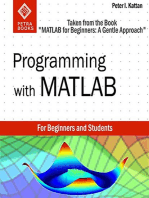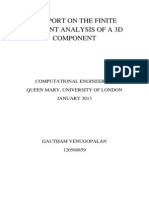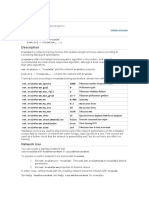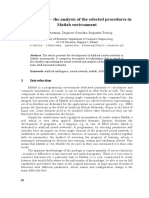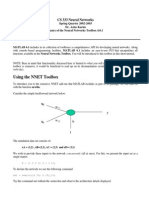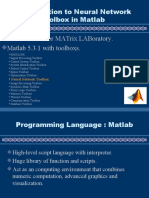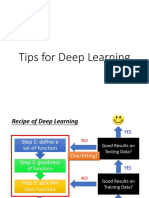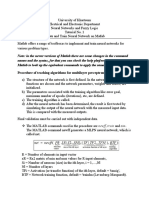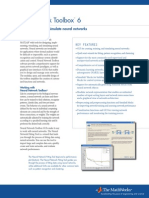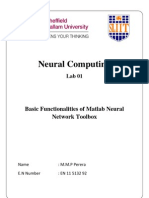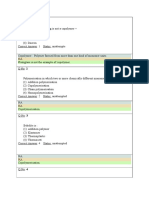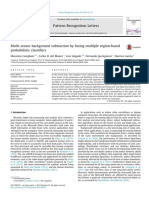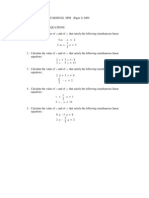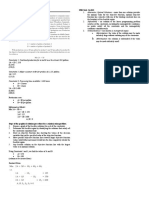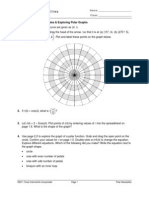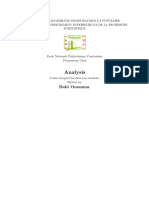Trainlm (Neural Network Toolbox)
Uploaded by
savisuTrainlm (Neural Network Toolbox)
Uploaded by
savisu26/12/2016
trainlm(NeuralNetworkToolbox)
trainlm
LevenbergMarquardtbackpropagation
Syntax
[net,TR]=trainlm(net,Pd,Tl,Ai,Q,TS,VV,TV)
info=trainlm(code)
Description
trainlmisanetworktrainingfunctionthatupdatesweightandbiasvaluesaccordingtoLevenbergMarquardt
optimization.
trainlm(net,Pd,Tl,Ai,Q,TS,VV,TV)takestheseinputs,
netNeuralnetwork.
PdDelayedinputvectors.
TlLayertargetvectors.
AiInitialinputdelayconditions.
QBatchsize.
TSTimesteps.
VVEitheremptymatrix[]orstructureofvalidationvectors.
TVEitheremptymatrix[]orstructureofvalidationvectors.
andreturns,
netTrainednetwork.
TRTrainingrecordofvariousvaluesovereachepoch:
TR.epochEpochnumber.
TR.perfTrainingperformance.
TR.vperfValidationperformance.
TR.tperfTestperformance.
TR.muAdaptivemuvalue.
Trainingoccursaccordingtothetrainlm'strainingparametersshownherewiththeirdefaultvalues:
net.trainParam.epochs100Maximumnumberofepochstotrain
net.trainParam.goal0Performancegoal
net.trainParam.max_fail5Maximumvalidationfailures
http://wwwrohan.sdsu.edu/doc/matlab/toolbox/nnet/trainlm.html
1/3
26/12/2016
trainlm(NeuralNetworkToolbox)
net.trainParam.mem_reduc1Factortouseformemory/speed
tradeoff
net.trainParam.min_grad1e10Minimumperformancegradient
net.trainParam.mu0.001InitialMu
net.trainParam.mu_dec0.1Mudecreasefactor
net.trainParam.mu_inc10Muincreasefactor
net.trainParam.mu_max1e10MaximumMu
net.trainParam.show25Epochsbetweenshowingprogress
net.trainParam.timeinfMaximumtimetotraininseconds
Dimensionsforthesevariablesare:
PdNoxNixTScellarray,eachelementP{i,j,ts}isaDijxQmatrix.
TlNlxTScellarray,eachelementP{i,ts}isaVixQmatrix.
AiNlxLDcellarray,eachelementAi{i,k}isanSixQmatrix.
where
Ni=net.numInputs
Nl=net.numLayers
LD=net.numLayerDelays
Ri=net.inputs{i}.size
Si=net.layers{i}.size
Vi=net.targets{i}.size
Dij=Ri*length(net.inputWeights{i,j}.delays)
IfVVorTVisnot[],itmustbeastructureofvectors,
VV.PD,TV.PDValidation/testdelayedinputs.
VV.Tl,TV.TlValidation/testlayertargets.
VV.Ai,TV.AiValidation/testinitialinputconditions.
VV.Q,TV.QValidation/testbatchsize.
VV.TS,TV.TSValidation/testtimesteps.
Validationvectorsareusedtostoptrainingearlyifthenetworkperformanceonthevalidationvectorsfailsto
improveorremainsthesameformax_failepochsinarow.Testvectorsareusedasafurthercheckthatthe
networkisgeneralizingwell,butdonothaveanyeffectontraining.
trainlm(code)returnsusefulinformationforeachcodestring:
http://wwwrohan.sdsu.edu/doc/matlab/toolbox/nnet/trainlm.html
2/3
26/12/2016
trainlm(NeuralNetworkToolbox)
'pnames'Namesoftrainingparameters.
'pdefaults'Defaulttrainingparameters.
NetworkUse
Youcancreateastandardnetworkthatusestrainlmwithnewff,newcf,ornewelm.
Toprepareacustomnetworktobetrainedwithtrainlm:
1.Setnet.trainFcnto'trainlm'.Thiswillsetnet.trainParamtotrainlm'sdefaultparameters.
2.Setnet.trainParampropertiestodesiredvalues.
Ineithercase,callingtrainwiththeresultingnetworkwilltrainthenetworkwithtrainlm.
Seenewff,newcf,andnewelmforexamples.
Algorithm
trainlmcantrainanynetworkaslongasitsweight,netinput,andtransferfunctionshavederivativefunctions.
BackpropagationisusedtocalculatetheJacobianjXofperformanceperfwithrespecttotheweightandbias
variablesX.EachvariableisadjustedaccordingtoLevenbergMarquardt,
jj=jX*jX
je=jX*E
dX=(jj+I*mu)\je
whereEisallerrorsandIistheidentitymatrix.
Theadaptivevaluemuisincreasedbymu_incuntilthechangeaboveresultsinareducedperformancevalue.The
changeisthenmadetothenetworkandmuisdecreasedbymu_dec.
Theparametermem_reducindicateshowtousememoryandspeedtocalculatetheJacobianjX.Ifmem_reducis1,
thentrainlmrunsthefastest,butcanrequirealotofmemory.Increasingmem_reducto2cutssomeofthe
memoryrequiredbyafactoroftwo,butslowstrainlmsomewhat.Highervaluescontinuetodecreasethe
amountofmemoryneededandincreasetrainingtimes.
Trainingstopswhenanyoftheseconditionsoccur:
Themaximumnumberofepochs(repetitions)isreached.
Themaximumamountoftimehasbeenexceeded.
Performancehasbeenminimizedtothegoal.
Theperformancegradientfallsbelowmingrad.
muexceedsmu_max.
Validationperformancehasincreasedmorethanmax_failtimessincethelasttimeitdecreased(when
usingvalidation).
SeeAlso
newff,newcf,traingd,traingdm,traingda,traingdx
http://wwwrohan.sdsu.edu/doc/matlab/toolbox/nnet/trainlm.html
3/3
You might also like
- Programming with MATLAB: Taken From the Book "MATLAB for Beginners: A Gentle Approach"From EverandProgramming with MATLAB: Taken From the Book "MATLAB for Beginners: A Gentle Approach"4.5/5 (3)
- Simulation of Some Power System, Control System and Power Electronics Case Studies Using Matlab and PowerWorld Simulator ProgramsFrom EverandSimulation of Some Power System, Control System and Power Electronics Case Studies Using Matlab and PowerWorld Simulator ProgramsNo ratings yet
- Answers To Final Exam: MA441: Algebraic Structures I 20 December 2003No ratings yetAnswers To Final Exam: MA441: Algebraic Structures I 20 December 20035 pages
- Neural Network Toolbox: A Tutorial For The Course Computational IntelligenceNo ratings yetNeural Network Toolbox: A Tutorial For The Course Computational Intelligence8 pages
- Using The NNET Toolbox: CS 537 Neural NetworksNo ratings yetUsing The NNET Toolbox: CS 537 Neural Networks11 pages
- Using The NNET Toolbox: CS 333 Neural NetworksNo ratings yetUsing The NNET Toolbox: CS 333 Neural Networks11 pages
- Introduction To Neural Network Toolbox in Matlab: Matlab Stands For Matrix Laboratory. Matlab 5.3.1 With ToolboxsNo ratings yetIntroduction To Neural Network Toolbox in Matlab: Matlab Stands For Matrix Laboratory. Matlab 5.3.1 With Toolboxs22 pages
- Lecture 5 - Multi-Layer Feedforward Neural Networks Using Matlab Part 1No ratings yetLecture 5 - Multi-Layer Feedforward Neural Networks Using Matlab Part 14 pages
- Introduction To Neural Network Toolbox in Matlab: Matlab Stands For Matrix Laboratory. Matlab 5.3.1 With ToolboxsNo ratings yetIntroduction To Neural Network Toolbox in Matlab: Matlab Stands For Matrix Laboratory. Matlab 5.3.1 With Toolboxs22 pages
- Deep Learning With Matlab Quick Start Guide PDFNo ratings yetDeep Learning With Matlab Quick Start Guide PDF1 page
- Levenberg-Marquardt Backpropagation - MATLAB TrainlmNo ratings yetLevenberg-Marquardt Backpropagation - MATLAB Trainlm2 pages
- 1725876123-Unit 1 Fundamental of Deep LearningNo ratings yet1725876123-Unit 1 Fundamental of Deep Learning51 pages
- Lecture 10 - Supervised Learning in Neural Networks - (Part 3)No ratings yetLecture 10 - Supervised Learning in Neural Networks - (Part 3)2 pages
- Neural Network Toolbox 6: Design and Simulate Neural NetworksNo ratings yetNeural Network Toolbox 6: Design and Simulate Neural Networks4 pages
- Introduction To Matlab Neural Network ToolboxNo ratings yetIntroduction To Matlab Neural Network Toolbox10 pages
- Simulation of Some Power System, Control System and Power Electronics Case Studies Using Matlab and PowerWorld SimulatorFrom EverandSimulation of Some Power System, Control System and Power Electronics Case Studies Using Matlab and PowerWorld SimulatorNo ratings yet
- Backpropagation: Fundamentals and Applications for Preparing Data for Training in Deep LearningFrom EverandBackpropagation: Fundamentals and Applications for Preparing Data for Training in Deep LearningNo ratings yet
- Ordered Weighted Averaging Aggregation Operator: Fundamentals and ApplicationsFrom EverandOrdered Weighted Averaging Aggregation Operator: Fundamentals and ApplicationsNo ratings yet
- Gesture Recognition With The Leap Motion Controller: 2. Problem DescriptionNo ratings yetGesture Recognition With The Leap Motion Controller: 2. Problem Description7 pages
- The Fundamental Steps of Leap Motion Combination in Your Unity 3D Project - 【126Kr】 PDFNo ratings yetThe Fundamental Steps of Leap Motion Combination in Your Unity 3D Project - 【126Kr】 PDF4 pages
- Gesture Recognition With The Leap Motion ControllerNo ratings yetGesture Recognition With The Leap Motion Controller8 pages
- Dynamic Pooling and Unfolding Recursive Autoencoders For Paraphrase DetectionNo ratings yetDynamic Pooling and Unfolding Recursive Autoencoders For Paraphrase Detection9 pages
- Computer Applications in Chemical EngineeringNo ratings yetComputer Applications in Chemical Engineering28 pages
- U5 L6 Applicationsof Quadratic Functions Day 1No ratings yetU5 L6 Applicationsof Quadratic Functions Day 14 pages
- Linear Programming: Sensitivity Analysis and Interpretation of SolutionNo ratings yetLinear Programming: Sensitivity Analysis and Interpretation of Solution6 pages
- North South University Department of Mathematics and PhysicsNo ratings yetNorth South University Department of Mathematics and Physics4 pages
- MANSCI: Introduction To Linear Programming Special CasesNo ratings yetMANSCI: Introduction To Linear Programming Special Cases1 page
- Polar Necessities: Part 1 - Plotting Coordinates & Exploring Polar GraphsNo ratings yetPolar Necessities: Part 1 - Plotting Coordinates & Exploring Polar Graphs2 pages
- Doubtnut Today: Class 9 Foundation Course Linear Equations in Two VariablesNo ratings yetDoubtnut Today: Class 9 Foundation Course Linear Equations in Two Variables5 pages
- MTH301 Midterm Solved MCQs With Reference by StudentsNo ratings yetMTH301 Midterm Solved MCQs With Reference by Students9 pages
- This Content Downloaded From 181.65.0.35 On Tue, 21 Jun 2022 15:25:18 UTCNo ratings yetThis Content Downloaded From 181.65.0.35 On Tue, 21 Jun 2022 15:25:18 UTC7 pages
- Elements of Mathematical Analysis Author Harald Hanche-OlsenNo ratings yetElements of Mathematical Analysis Author Harald Hanche-Olsen31 pages
- Approximating Eigenvalues: Darya FilatovaNo ratings yetApproximating Eigenvalues: Darya Filatova65 pages
- Modern Numerical Methods For Fluid Flow - Phillip Colella PDF100% (1)Modern Numerical Methods For Fluid Flow - Phillip Colella PDF158 pages
- Solution of 2D Convection-Diffusion Transient Problems by A Fractional-Step FE MethodNo ratings yetSolution of 2D Convection-Diffusion Transient Problems by A Fractional-Step FE Method11 pages

